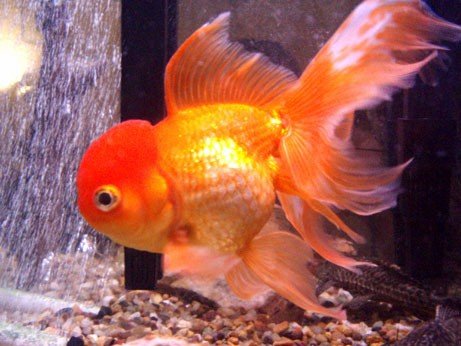 An oranda is a fancy goldfish characterized by a prominent raspberry-like hood encasing its head. The hood or headgrowth (also known as wen in Chinese) encases the whole head except for the eyes and mouth.[1][2][3]
An oranda is a fancy goldfish characterized by a prominent raspberry-like hood encasing its head. The hood or headgrowth (also known as wen in Chinese) encases the whole head except for the eyes and mouth.[1][2][3]
Description
Due to the fleshy outgrowth on the top of its head and sides of its face, the oranda has become one of the most popular goldfish. The oranda is a metallic or matte scaled goldfish that is similar in appearance to the veiltail. It has a large, long and deep body accompanied by a long quadruple tail. This four-lobed and contracted tail normally spreads out broadly when the oranda stops swimming. The back does not rise up to form a ryukin-like hump.[2][3]
Orandas are available in orange, red, red-and-white, red-and-black, black, blue, chocolate, bronze, white or silver, black-and-white (panda-colored), red-black-and-white (tricolor), and calico colors.[1][2][3]
The headgrowth of young fry may take one to two years to develop.[1][2]
The oranda can reach 8 to 12 inches (20 to 31 centimeters) in length.[2][3]
Oranda goldfish are especially sensitive to cold temperatures, more so than other goldfish.
Trivia
A specimen from China, named "Bruce", has attained 15 inches in length.[1]
The azuma nishiki is an attractive nacreous-colored form of the oranda.[2]
The red-cap oranda has a silver body with a prominent red headgrowth on the forehead.[2]
Chinese breeders have developed telescope eyed orandas, a cross-breeding of the telescope eye and oranda goldfishes.[3]
The hana fusa or white pompom oranda is an elegant pompom with a dorsal fin.[2]
Special care
Orandas are sensitive to low water temperatures and susceptible to the attention of other active goldfish.[2]
http://en.wikipedia.org/wiki/Oranda
 |
| toolbar powered by Conduit |








